Roger Linn
Roger Linn is an American industrial designer, mainly of electronic drum machines, and has recently branched out into guitar effects pedals.[1] He is known for designing the first drum machine to use digital samples. His products have become underground hits, being used on many famous recordings. Besides being an accomplished guitarist and producer, Roger Linn is also a member of the Dead Presidents Society, a group of distinguished innovators in the field of electronic music.[2]
Linn Electronics
In 1979, Roger Linn and Alex Moffett[3] co-founded Linn Moffett Electronics (soon to be renamed Linn Electronics) to develop Linn's design for a drum machine that uses digital samples. It would be called LM-1 for Linn/Moffett/1. Moffett would leave the company in 1982.
LM-1
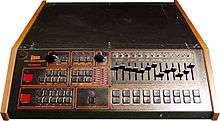
In 1980, Roger Linn revolutionized the world of electronic musical instruments with the release of the world's first drum machine to use digital samples, the LM-1 Drum Computer.[4] The LM-1 was the first drum machine to use samples of a real drum kit, though Roger Linn cannot recall exactly which session drummer played the sounds that he used.[4] To further add to the mystery, an entry in the online museum of the Roger Linn Design company credits L.A. session drummer Art Wood with most of the samples.[5] Examples of the LM-1 in use can be found on recordings by Prince, Gary Numan, and Michael Jackson.[1]
LinnDrum
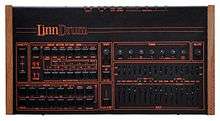
In 1982 Linn released the LinnDrum as the successor to the LM-1. It improved on the LM-1 in some ways like the addition of crash and ride cymbal samples. One drawback: on the LinnDrum only the snare, tom and conga samples can be tuned, whereas the LM-1 allows every sound to be individually tuned. Its high-quality samples, flexibility and affordability made the LinnDrum popular. It sold more units than its predecessor (the LM-1) and its successor (the Linn 9000) combined. The LinnDrum was used on countless recordings throughout the 1980s, including a-Ha's international hit "Take on Me".
Linn 9000
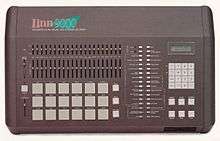
In 1984 Linn released the Linn 9000 as the successor to the LinnDrum. It was the first integrated digital drum machine and MIDI sequencer. The 9000 had innovative features, like dynamic sensitive rubber pads,[6] and would influence many future drum machine designs.[7] But chronic software bugs[8][9] led to a reputation for unreliability and contributed to the eventual demise of the company.[10][11] The 9000 can be heard on Michael Jackson's 1987 album, Bad, on the cuts "Bad", "Man in the Mirror" and "Liberian Girl".
LinnSequencer
In 1985 Linn released the LinnSequencer, a rack mount 32 track hardware MIDI sequencer. It used the same flawed operating system used in the Linn 9000.[12] As a result, the machine earned a reputation for unreliability.[8][9]
LinnDrum Midistudio

In January 1986, Linn debuted the LinnDrum Midistudio at the Winter NAMM Show as the successor to the Linn 9000. The Midistudio is essentially a rack mount version of the Linn 9000 with some improvements.[13] It used the same flawed operating system used in the Linn 9000.[14] It never went into production because Linn Electronics went out of business the following month.[15]
Similarities between the LinnDrum Midistudio and the Akai MPC series lead some to perceive a family resemblance.[16][17][18] Most notably, the Midistudio has sixteen dynamic sensitive rubber pads in the distinctive, four by four pattern, that would become the hallmark of the MPCs, starting with the MPC60.
Legacy
Linn Electronics went out of business in February 1986. Forat Electronics purchased their remaining assets,[19] manufactured and sold the Forat F9000 and LinnSequencer until 1994 and provide service, sounds, customization and upgrades for the entire Linn Electronics line.
The LM-1, LinnDrum and Linn 9000 became synonymous with the music of the 1980s. The Linn 9000 and LinnDrum Midistudio pioneered the concept of the Music Production Center or MPC.
Akai MPC Series

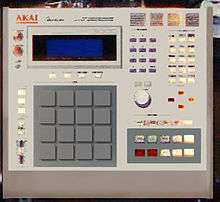
After Linn Electronics, Roger Linn was recruited by the Japanese company Akai to help in designing the MPC60, an integrated digital sampling drum machine and MIDI sequencer released in 1988. This would be the first in a line of Akai MIDI Production Centers or MPCs. Released in 1994, the MPC3000 improved upon the MPC60. It would be the last product of the Akai/Roger Linn collaboration.[1] The Akai MPCs enjoyed great popularity, particularly among musicians producing Hip Hop and similar styles.
Roger Linn Design
As of 2001, Roger Linn has founded a new company, Roger Linn Design. RLD's products so far are the AdrenaLinn series of guitar pedals, now updated to a third version, and the LinnStrument music performance controller.
AdrenaLinn
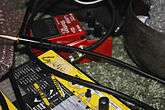
The AdrenaLinn is a digital multi-effects unit with a drum machine and amp modeler all in one, designed by Roger Linn with some help from Dave Smith (credited with helping to conceive MIDI) and Tom Oberheim (designer of early analog synthesizers). Most notably, unlike other guitar pedals, the AdrenaLinn specializes in beat-synced effects, including modulation and delay but also a sequencer that provides looped patterns of filtered tones, all moving in sync to its internal drum machine or to midi. The drum section can also be affected by the filter section, allowing dance-style beats. Other unusual aspects of this pedal include note-triggered filter effects such as auto-wah, simulated talk box and guitar synthesizer sounds. The AdrenaLinn technology was also the basis of Roger Linn's partnership with M-Audio to create the Black Box guitar multi-effect and recording unit.[1]
The AdrenaLinn can be heard on the following records (among many others):
- John Mayer – "Heartbreak Warfare", from the 2009 album "Battle Studies", "Bigger Than My Body" from the 2003 album "Heavier Things" and "I Don't Trust Myself (With Loving You)" from the 2006 album "Continuum"
- Green Day – "Boulevard of Broken Dreams" from the 2004 album "American Idiot"
- Red Hot Chili Peppers – By The Way – Warner Bros. – 2002 (produced by Rick Rubin)
- Morcheeba – Parts Of The Process – Reprise Records – 2003
- Marillion – Marbles – 2004[20]
The AdrenaLinn was followed-up with the AdrenaLinn II and AdrenaLinn III.
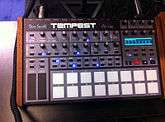
LinnDrum II
Roger Linn and Dave Smith announced co-development of a drum machine product, originally to be called BoomChik, but changed to LinnDrum II in December 2007, a reference to one of Linn's early popular drum machines: the LinnDrum. The LinnDrum II was renamed the Tempest, and co-released by Roger Linn Designs and Dave Smith Instruments in 2011.
.jpg)
LinnStrument
In late 2014 Linn released the LinnStrument, a music performance controller with 3D note expression, after several years of development. The grid based MIDI controller, playable with one or two hands, is velocity sensitive, but also senses three dimensions per finger, polyphonically.
Music career
Roger Linn has had a level of songwriting success, penning hits ("Promises", Eric Clapton 1979; "Quittin' Time", Lou Ann Barton 1986, Mary Chapin Carpenter 1991, Amy Bishop 2009), and having toured as a guitarist with the pianist/songwriter Leon Russell in the 1970s at age 21.[1]
In 2011 Roger was awarded a Grammy Award for Lifetime Technical Achievement, recognizing his many contributions to the music recording industry.[21][22]
References
- 1 2 3 4 5 Roger Linn Design: About Roger Linn
- ↑ Dead Presidents Society
- ↑ Moffett, Alex. "Alex Moffett - LinkedIn". Retrieved 6 April 2015.
- 1 2 Hey, what's that sound: Linn LM-1 Drum Computer and the Oberheim DMX by David McNamee The Guardian
- ↑ Roger Linn Design: Past Products Museum
- ↑ "...the Linn 9000 remains one of the true innovative designs of it's decade.". Total Trash. The Linn 9000 Home Page.
- ↑ "Brothers, Sisters, and Cousins: Similar Drum Machines". Total Trash. The Linn 9000 Home Page.
- 1 2 "...but bugged by many OS troubles and technical issues.". Polynominal.
- 1 2 "...it was plagued with operating system bugs...". Total Trash. The Linn 9000 Home Page.
- ↑ Linn, Roger. "What happened? We simply ran out of money and were unable to get more. Why? There were a number of reasons. The 9000 had technical problems early on and was expensive to re-engineer, manufacturer and service; we had strong competition; we had no investment financing; and we were experiencing all the classic "growing pains" of a new business.". Bobby Nathan's Keyboard Magazine "In The Studio" Article #17 "What Happened to The Linn 9000".
- ↑ "one the most unreliable and buggy machine ever made, in fact this ground-breaking and expensive project bankrupted the Linn company.". Polynominal.
- ↑ Linn, Roger. "...we sent out one copy of the new version 5.17 software ROMs for the 9000 and LinnSequencer...". Bobby Nathan's Keyboard Magazine "In The Studio" Article #17 "What Happened to The Linn 9000".
- ↑ "MidiStudio - Synthony Music's Synth & Midi Museum".
- ↑ Linn, Roger. "[Q] What will happen to the new product, the LinnDrum Midistudio? [A] No Midistudios were ever shipped. If I cannot re-start Linn, there is a good chance that some other company will purchase the designs to both the Midistudio and the LinnSequencer and then manufacture and distribute them. In that event, there is also a chance that the company might make further software updates for the 9000 available since the software for all three products is nearly the same.". Bobby Nathan's Keyboard Magazine "In The Studio" Article #17 "What Happened to The Linn 9000".
- ↑ "Roger Linn Design - Past Products Museum".
- ↑ "So, was the Midistudio the direct descendent to the MPC range, that then continued on to evolve into my broken down MPC2000xl and beyond? I'm gonna say yes, even if it never made it into production. The 4x4 pads, the beige colouring, and the few references I've found online is good enough evidence to me.". Linn Electronics Inc. LinnDrum Midistudio "Put a complete studio in your lap." ad, Keyboard 1986 - Retro Synth Ads - Atom. May 19, 2011. Retrieved February 21, 2015.
- ↑ "Blogged: '86 LinnDrum Midistudio - father to @Akai_Pro 's MPC? 4x4 pads and color!". RetroSynthAds:. May 19, 2014. Retrieved February 21, 2015.
- ↑ "The LinnDrum Midistudio looks like the true predecessor to the MPC, they moved from the 6x3 pad layout of the Linn 9000 to the familiar 4x4 pad layout with the LinnDrum Midistudio prototype, and the remote pad surface seems to have the Akai cream colour, along with the MPC style layout of pads/transport/controls/etc., just before Linn went broke... The Linn 9000, Linn Sequencer, LinnDrum Midistudio, and Akai ADR15 would represent the refinement of Linn's previous ideas/products into the MPC design, possibly with the sampled drum idea coming from the replaceable ROM sound chips in the LinnDrum.". Akai MPC Forums - Researching a book on the MPC60 - Thoughts? : MPC3000, MPC60. October 24, 2012. Retrieved February 21, 2015.
- ↑ "Then in 1986 Forat Electronics Corporation was born after purchasing Linn's remaining assets...". Forat Electronics - History.
- ↑ Roger Linn Design: AdrenaLinn or AdrenaLinn II
- ↑ Rundgren, Todd (February 1, 2011). "Technical GRAMMY Award: Roger Linn". GRAMMY.com. Retrieved June 17, 2011.
- ↑ "Roger Linn at Special Merit Awards Ceremony & Nominees Reception". GRAMMY.com. February 13, 2011. Retrieved June 17, 2011.
External links
- Akaipro.com
- Roger Linn Design
- About Roger Linn; biography, video interview by Sweetwater Sound
- A BBC Radio 4 programme devoted to Roger Linn's drum machines.
- LinnDrum II
- LinnStrument
- The Linn 9000 Homepage
- Mr. MPC: Roger Linn
- Linn MidiStudio (a very early prototype of the MPC60)
- Auction on VEMIA listing the Linn MidiStudio
- Dead Presidents Society - Roger Linn Design
- Dead Presidents Society Discuss Equipment Design
- Dead Presidents Society - YouTube
- NAMM (National Association of Music Merchants) Oral History Interview with Roger Linn January 20, 2005